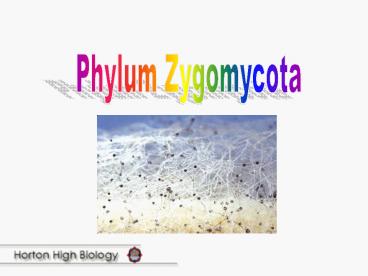Phylum Zygomycota - PowerPoint PPT Presentation
1 / 7
Title:
Phylum Zygomycota
Description:
They are mostly saprobic, but some are parasitic, living on plants, insects, and ... The white/grey mycelium consists of several kinds of hyphae... – PowerPoint PPT presentation
Number of Views:1229
Avg rating:3.0/5.0
Title: Phylum Zygomycota
1
Phylum Zygomycota
2
General Characteristics
- They produce a special type of thick walled
spore, which develop from zygotes during sexual
reproduction. - They are mostly saprobic, but some are parasitic,
living on plants, insects, and other fungi.
3
Structure of Bread Mold
- The white/grey mycelium consists of several kinds
of hyphae - Root like hyphae which anchors mold,
secretes digestive enzymes, and absorbs
nutrients. These are called rhizoids - Stolons which grow over the surface of the
food. - Sporangiophores grow up from the stolons.
At the tip of each is a round spore case called a
sporangium.
4
ChitinWhy So Important?
- Chitin is the substance found in the cell walls
of fungi. - It shimmers, and has a crystalline appearance.
- It is important in making the fungus resistant to
dryness, and makes it more durable because of its
strength.
5
Reproduction of Bread Mold
- Large numbers of spores form in each sporangium.
- When the case opens at maturity, the spores are
released. - If they land in favourable environments, they
will germinate and form a new mycelium.
6
Sexual Reproduction
- Sexual reproduction occurs through conjugation.
- Here, different strains of hyphae touch each
other, and form a hardened zygospore, that can
survive harsh conditions - Inside, the and nuclei will have joined to
form a new diploid nuclei. - If conditions are favourable, the zygospore will
germinate. - Upon meiosis, only one haploid nucleus remains,
as the other three will degenerate. - The new haploid cell, will then give rise to a
sporangiophore, which will go on to reproduce
asexually.
7
(No Transcript)































